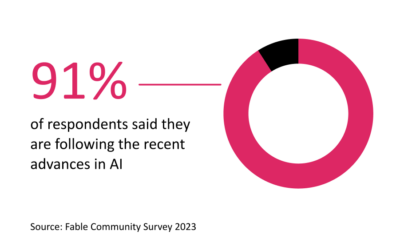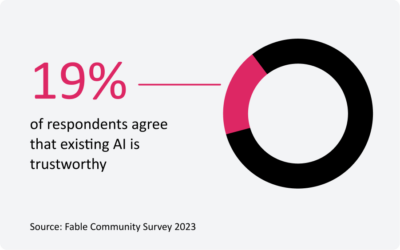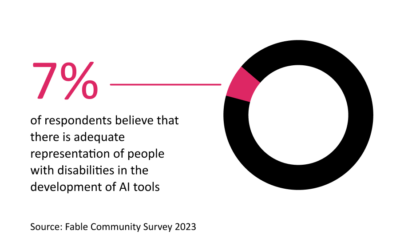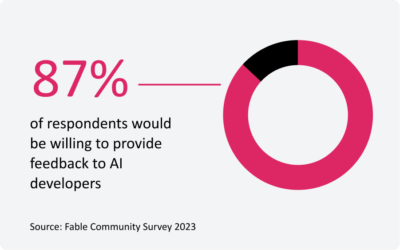
Insights: AI and Accessibility
Introduction
Artificial intelligence (AI) has the potential to change how we work, socialize, shop, and access critical services like healthcare. Growth in AI is happening exponentially, and it’s faster than most of us can keep up with. It’s exciting and scary at the same time, but especially scary for some.
The speed of new AI developments comes with the potential to accelerate the inclusion, or exclusion, of people with disabilities. The impact of AI will depend on the people who are generating and choosing data sets, writing, and testing algorithms, and building interfaces to leverage AI.
To better understand how people with disabilities are thinking about AI and their concerns for the future of AI, Fable surveyed our community of assistive technology users. This article outlines what we learned and makes recommendations for creating more inclusive AI tools.
AI momentum is building
Tech news has been taken over by the latest AI trends and tools. Many of us are paying close attention to new developments in the field, including the Fable community. 91% of respondents to our survey said they are following the recent advances in AI.
A number of AI advances related to accessibility were announced on May 18th, Global Accessibility Awareness Day:
- Apple: new features for cognitive accessibility, along with Live Speech, Personal Voice, and Point and Speak in Magnifier
- Google: 5 products and features that make the digital world more accessible
- Microsoft: Global Accessibility Awareness Day – Accessibility at the heart of innovation
The Fable community has been exploring new tools in this space. For example, 54% have used ChatGPT. Other examples of AI adoption include ElevenLabs for text to speech, Seeing AI to identify objects with their smartphone camera, and DALL·E to generate images.

AI momentum is building
Tech news has been taken over by the latest AI trends and tools. Many of us are paying close attention to new developments in the field, including the Fable community. 91% of respondents to our survey said they are following the recent advances in AI.
A number of AI advances related to accessibility were announced on May 18th, Global Accessibility Awareness Day:
- Apple: new features for cognitive accessibility, along with Live Speech, Personal Voice, and Point and Speak in Magnifier
- Google: 5 products and features that make the digital world more accessible
- Microsoft: Global Accessibility Awareness Day – Accessibility at the heart of innovation
The Fable community has been exploring new tools in this space. For example, 54% have used ChatGPT. Other examples of AI adoption include ElevenLabs for text to speech, Seeing AI to identify objects with their smartphone camera, and DALL·E to generate images.

AI isn’t trusted, yet
There are concerns around the trustworthiness of AI with only 19% of respondents agreeing that existing AI is trustworthy. The reality is that AI tools have varying degrees of accuracy depending on the task.
For example, if you ask AI image generators to create a picture of a blind woman with a guide dog, they’ll have difficulty generating a harness for the dog and will likely show the dog on a leash, which isn’t the widely used method of navigating with a guide dog. These gaps in accuracy are caused by gaps in training data sets. There aren’t a lot of photos of blind people to train AI on because photo shoots don’t commonly include disabled models.
There’s also no way to verify the accuracy of the images generated. AI tools need to be transparent when they fill in data gaps with guesses.

Hope for benefits in the future
On the plus side, two out of three respondents said that recent advancements in AI have had a positive effect on their life. There’s a great deal of hope around how AI can continue to positively impact accessibility and inclusion in the future.
“I think if implemented correctly, AI could have impressively positive impacts on inclusivity and accessibility. AI could be the difference between being able to contribute in society and not being able to contribute and being able to access vital information more-readily and seamlessly than ever before.”
– Christina M., Screen reader user
“I think AI will have a big impact on accessibility. I think it could make difficult tasks for disabled people much easier.”
– Emma L., Alternative navigation user
“It may level the playing field for people with disabilities in allowing them to participate in activities that would have otherwise been challenging or impossible.”
– Charmaine C., Screen reader user
AI isn’t trusted, yet
There are concerns around the trustworthiness of AI with only 19% of respondents agreeing that existing AI is trustworthy. The reality is that AI tools have varying degrees of accuracy depending on the task.
For example, if you ask AI image generators to create a picture of a blind woman with a guide dog, they’ll have difficulty generating a harness for the dog and will likely show the dog on a leash, which isn’t the widely used method of navigating with a guide dog. These gaps in accuracy are caused by gaps in training data sets. There aren’t a lot of photos of blind people to train AI on because photo shoots don’t commonly include disabled models.
There’s also no way to verify the accuracy of the images generated. AI tools need to be transparent when they fill in data gaps with guesses.

Hope for benefits in the future
On the plus side, two out of three respondents said that recent advancements in AI have had a positive effect on their life. There’s a great deal of hope around how AI can continue to positively impact accessibility and inclusion in the future.
“I think if implemented correctly, AI could have impressively positive impacts on inclusivity and accessibility. AI could be the difference between being able to contribute in society and not being able to contribute and being able to access vital information more-readily and seamlessly than ever before.”
– Christina M., Screen reader user
“I think AI will have a big impact on accessibility. I think it could make difficult tasks for disabled people much easier.”
– Emma L., Alternative navigation user
“It may level the playing field for people with disabilities in allowing them to participate in activities that would have otherwise been challenging or impossible.”
– Charmaine C., Screen reader user
Assistive tech users need to be considered
Members of the Fable community don’t always feel that their needs are being considered as AI advances. Half of respondents that have engaged with AI technology encountered barriers or challenges when using AI due to their disability.
“Bard, OpenAI and Bing all have the issue that new content received from them when you ask a question is not automatically read by screen reading technology.”
– Martin C., Screen reader user
“Some barriers I experience are AI technology not being fully customizable, or having one or more functions that require mobility, like pushing a button to power it on, lower the volume, etc.”
– Remon J., Screen magnification and alternative nav user
While we don’t have exact numbers on assistive technology usage, the World Health Organization estimates 900 million people need assistive products, which includes assistive technology.1
Representation of assistive technology users in the development of AI technology and the data sets used to train machine learning models will be critical to ensuring that AI can benefit more people. According to our survey, only 7% of respondents believe that there is adequate representation of people with disabilities in the development of AI tools.
For example, for everyone to benefit from AI tools that use voice interactions, you need to train it with a diversity of voices. People with ALS, Down Syndrome, and people who are Deaf, and many more diverse voices need to be included. If you don’t involve the end users in the design process, the AI solutions are unlikely to be widely adopted.

Assistive tech users need to be considered
Members of the Fable community don’t always feel that their needs are being considered as AI advances. Half of respondents that have engaged with AI technology encountered barriers or challenges when using AI due to their disability.
“Bard, OpenAI and Bing all have the issue that new content received from them when you ask a question is not automatically read by screen reading technology.”
– Martin C., Screen reader user
“Some barriers I experience are AI technology not being fully customizable, or having one or more functions that require mobility, like pushing a button to power it on, lower the volume, etc.”
– Remon J., Screen magnification and alternative nav user
While we don’t have exact numbers on assistive technology usage, the World Health Organization estimates 900 million people need assistive products, which includes assistive technology.1
Representation of assistive technology users in the development of AI technology and the data sets used to train machine learning models will be critical to ensuring that AI can benefit more people. According to our survey, only 7% of respondents believe that there is adequate representation of people with disabilities in the development of AI tools.
For example, for everyone to benefit from AI tools that use voice interactions, you need to train it with a diversity of voices. People with ALS, Down Syndrome, and people who are Deaf, and many more diverse voices need to be included. If you don’t involve the end users in the design process, the AI solutions are unlikely to be widely adopted.

Fable testers are eager to participate in AI
Despite these challenges, there is an eager community of assistive technology users ready to help. 87% of respondents would be willing to provide feedback to AI developers to help them improve the accessibility and inclusivity of their products.
Not a single survey respondent felt that AI should continue to be developed without clear regulations and guidelines in place to ensure accessibility and inclusivity for people with disabilities. They believe that it is through their feedback that AI technology can become more inclusive of users of assistive technology.
Accessibility can also lead to more innovative solutions. Understanding the barriers faced by people with disabilities can spur creativity and better solutions for everyone. Some ideas the Fable community have include:
“I have hearing problems and really struggle with phone conversations. At the same time, I don’t like asking other people to handle phone calls for me because they will never do things the same way I would. I wish I could just tell an AI what I want done, and let it handle the phone calls for me.”
– Michelle B., Alternative navigation user
“As I have been exploring AI Services like Chat GPT, I have been amazed by its ability to understand computer code in multiple languages. I believe I could have put this to good use in my coding classes, having it assist me in figuring out what was wrong with the programs I was writing.”
– Cullen G., Screen reader user
“I type using an on-screen keyboard and it takes me a long time to type. It would be easier if AI was able to predict my next sentence and I could edit it from there.”
– Emma L., Alternative navigation user

Fable testers are eager to participate in AI
Despite these challenges, there is an eager community of assistive technology users ready to help. 87% of respondents would be willing to provide feedback to AI developers to help them improve the accessibility and inclusivity of their products.
Not a single survey respondent felt that AI should continue to be developed without clear regulations and guidelines in place to ensure accessibility and inclusivity for people with disabilities. They believe that it is through their feedback that AI technology can become more inclusive of users of assistive technology.
Accessibility can also lead to more innovative solutions. Understanding the barriers faced by people with disabilities can spur creativity and better solutions for everyone. Some ideas the Fable community have include:
“I have hearing problems and really struggle with phone conversations. At the same time, I don’t like asking other people to handle phone calls for me because they will never do things the same way I would. I wish I could just tell an AI what I want done, and let it handle the phone calls for me.”
– Michelle B., Alternative navigation user
“As I have been exploring AI Services like Chat GPT, I have been amazed by its ability to understand computer code in multiple languages. I believe I could have put this to good use in my coding classes, having it assist me in figuring out what was wrong with the programs I was writing.”
– Cullen G., Screen reader user
“I type using an on-screen keyboard and it takes me a long time to type. It would be easier if AI was able to predict my next sentence and I could edit it from there.”
– Emma L., Alternative navigation user

A more inclusive way forward for AI
“Technological progress has to be designed to support humanity’s progress and be aligned to human values. Among such values, equity and inclusion are the most central to ensure that AI is beneficial for all.”
– Francesca Rossi, AI Ethics Global Leader, IBM
We need to be able to discover cases of “statistical discrimination” caused when AI uses pattern matching or optimizes within a set of choices. People with disabilities and their needs can too easily be filtered out, unintentionally.
Implementing AI equity and safety protections is top of mind for more than 350 tech executives and researchers in the industry who have signed a statement urging policymakers recognize the risks of unregulated AI.
Our Innovation team at Fable is focused on three critical aspects of AI development.
The potential of inclusive AI
With its ability to analyze vast amounts of data and perform complex tasks, AI has the power to revolutionize accessibility for individuals with disabilities. From speech recognition to image recognition, AI technologies can enhance communication, navigation, and interaction for those with hearing, vision, mobility, and other disabilities. AI tools can automate mundane tasks and provide real-time assistance, enabling greater independence and inclusion for people with disabilities.
Right now, AI is being used in tools like Seeing AI and Be My Eyes, which help blind people interpret visual information. AI is also improving the accuracy of auto generated transcripts for people who are Deaf or hard of hearing through tools like Live Captions and Otter.ai. The time to focus on inclusion is now.
As AI continues to advance, it is critical for developers, data scientists, and researchers to ensure that AI solutions are designed inclusively. By harnessing the power of AI along with a focus on accessibility, we can create a future where technology breaks down barriers and empowers everyone to thrive.
